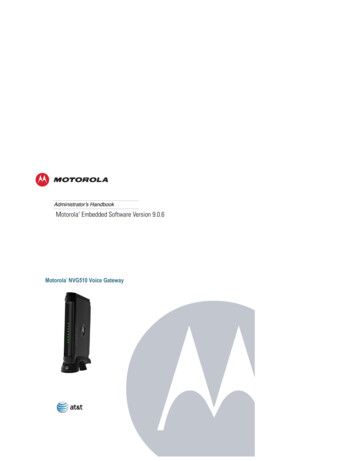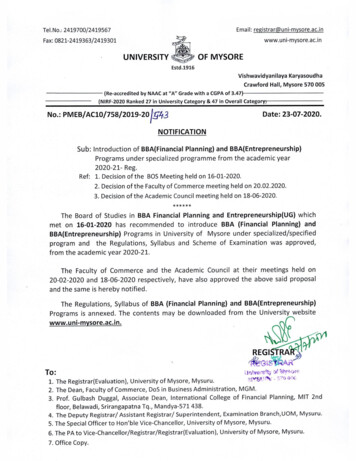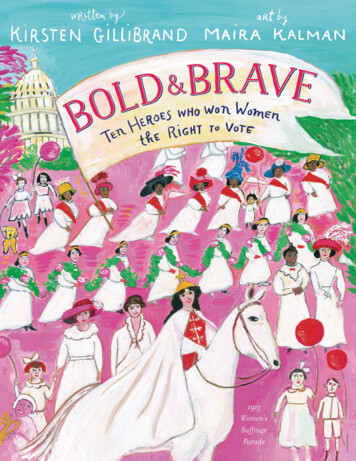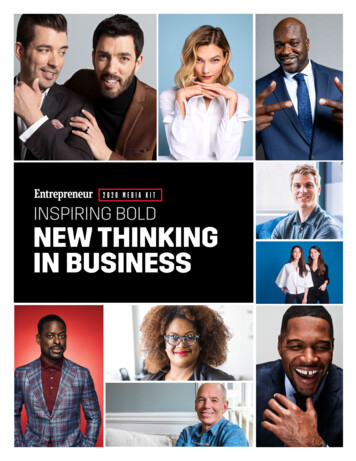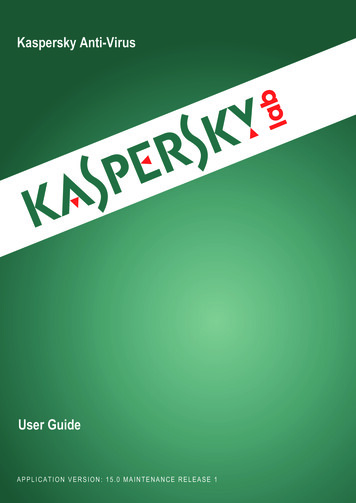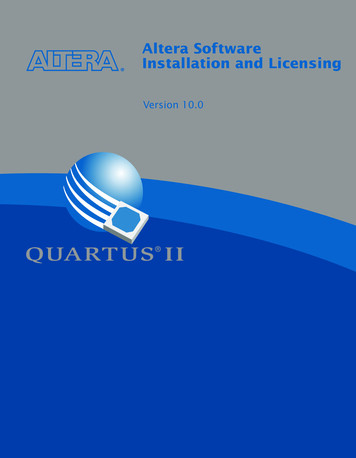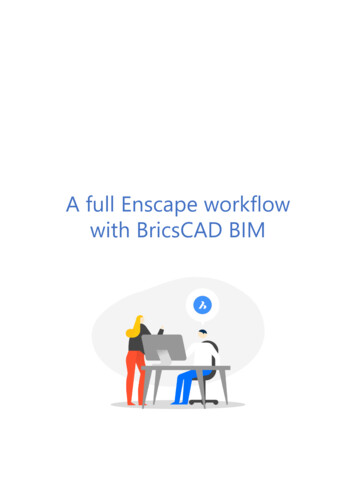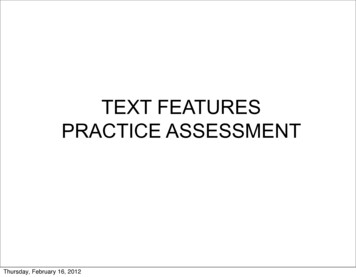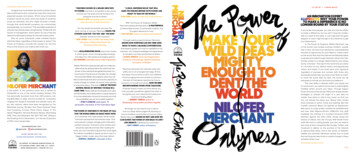
Transcription
Imagine how much better the world could be if everyidea could have its shot, not just the ones that come fromexpected people and places. Which long-intractableproblems would we solve, what new levels of creativitywould be unlocked, and who might innovate a breakthrough that could benefit ourselves, our communities,and especially our economy? This boundless potential ofonlyness has already been recognized by Thinkers 50, theOscars of management, which cited it as one of the fiveideas that will shape business for the next twenty years.Why do some individuals make scalable impactwith their ideas, regardless of their power or status? ThePower of Onlyness unravels this mystery for the firsttime so that anyone can make a dent. Even you.“ONLYNESS SHOWS US A BRAND-NEW PATHTO POWER: one that is accessible to the youngand the old, the quiet and the forceful, thesanguine and the troubled.”― SUSA N CA I N , bestselling author of Quietand cofounder of Quiet Revolution“A BOLD, INSPIRING BOOK THAT WILLLEAVE YOU FEELING INFUSED WITH POWER ANDREADY TO TAKE ON THE WORLD.”― DA N P INK , author of Drive and To Sell Is Human“With The Power of Onlyness, NiloferMerchant passes all three tests of A MASTERPIECE:“For any would-be activists who hear the1) memorable stories; 2) actionable insights; andvoice ‘not me’ or ‘not now,’ Merchant MAKES THE3) urgent relevance to now.”STRONG CASE FOR ‘YES YOU’ AND ‘YES NOW’ —and even shows you how to jump in.”― VA N J O N ES , host of CNN’s The Messy Truth,and author of Rebuild the Dream and― TOM P ETERS , author of In Search of Excellence“Through twenty powerful stories, MerchantThe Green Collar EconomySHOWS HOW EVERYONE CAN USE THEIR OWNIDEAS TO MAKE A VALUABLE CONTRIBUTION.“This is AN ILLUMINATING BOOK about the context‘onlyness’—our unique knowledge and experience—in which great, world-changing ideas emergeto transform our lives and the lives of others.”and take root, with stories and insights galore.”― CA ROL DW ECK , Lewis and Virginia EatonProfessor of Psychology, Stanford University,and author of Mindset“Nilofer Merchant’s spectacular gift is to make tangible what we already feel to be instinctual: thepower of the individual alongside the power of acommunity in the service of one idea can changethe world. But Nilofer also explains what may notfeel so instinctual: that all of us have the capacity tois the author of two previous books and is ranked bycreate change, no matter our social, racial, gender,or economic status. This book is ONE OF THE MOSTHOPEFUL PIECES OF WRITING I’VE READ IN ALONG TIME. Nilofer defines and explains the valueThinkers50 as one of the world’s leading thinkers. Sheof individuality and collaboration in equal measure.has personally launched more than 100 products, net-It’s a true celebration not just of humanity but of allting 18 billion in sales, and has worked for companiesthe possibilities we can accomplish together.”ranging from Apple to Autodesk and advises many others. Her visionary ideas have been recognized by TheWall Street Journal, The New York Times, Financial Times,Fast Company, Fortune, Marie Claire, Vogue, O, TheOprah Magazine, Harvard Business Review, Bloomberg,CNN, Time, and Mashable. Her 2013 TED Talk, “Sitting Isthe Smoking of Our Generation,” is in the top 10 percentof TED’s most viewed talks.“THE POWER OF ONLYNESS IS THE WAKE-UP CALLTHAT THE WORLD NEEDS SO BADLY RIGHT NOW.It’s a reminder that, quite simply, we all matter.That each perspective has inherent value. Thateach person’s unique vantage point is literally an i lo f e r m e r c h a n t . c o m@ n i lo f e r―STACY LONDON , style expert, TVpersonality, and author of The Truth About Style@ n i lo f e r m e r c h a n tj ac k e t d e s i g n : m at t v e ea u t h o r p h o t o g r a p h : c o o p e r b at e sposition of power. That each voice matters andshould be used. Be warned: after reading thisVIKINGwww.penguin.com printed in u.s.a. CANADA 36.00AN INNOVATION EXPERTILLUMINATES WHY YOUR POWERTO MAKE A DIFFERENCE IS NOLONGER BOUND BY YOUR STATUSIf you’re like most people, you wish you had the abilityto make a difference, but you don’t have the credentials or a seat at the table, or can’t get past the gatekeepers, or aren’t high enough in any hierarchy to getyour ideas heard.In The Power of Onlyness, Nilofer Merchant, onethat, in fact, we have now reached an unprecedentedVIKINGmoment of opportunity for your ideas to “make a dent”on the world. Now that the Internet has liberated ideasto spread and scale through networks rather than hierarchies, power is no longer determined by your status,but by “onlyness”—that spot in the world only you standin, a function of your distinct history and experiences,“Merchant discovers her onlyness when shevisions and hopes. If you build upon your signaturewalks out on an arranged marriage. At first,ingredient of purpose and connect with those whoshe doesn’t know what to call it, but a lifetimeare equally passionate, you have a new lever by whichof encouraging men and women to summonto move the world. Dent by dent, the world can bethe best of themselves teaches her how tonurture it—in herself and others. NOW WE NEEDHER EMPOWERING WORK MORE THAN EVER.reshaped to include you and what you believe in.This new ability is already within your grasp, butto command it, you need to know how to meaningfullyOnlyness doesn’t mean you work alone; youmobilize others around your ideas. Through inspira-train yourself, sometimes against the odds, totional and instructive stories, Merchant reveals provenrecognize your own value and increase yourstrategies to unleash the might of a new idea—nochance of finding allies!”― S H ER RY TU R K L E , author ofmatter how weird or wild it may seem—so that you,too, can disrupt the status quo. Nearly thirty storiesReclaiming Conversation and Alone Togethershow onlyness in action. Some are inspiring, like how“No longer do we need to worry aboutelite doors to script writers outside the establishmenthow our ideas will be judged. By showing usand how Talia Milgrom-Elcott’s 100kin10’s tiny staffFranklin Leonard’s Black List opened up Hollywood’show to mobilize communities around our ideas,mobilized the training of a hundred thousand STEMNilofer Merchant SHOWS US WHY AND HOW WEteachers against the odds. Other stories reveal theCAN ELEVATE THE POWER OF OUR IDEAS TO LIMITLESS HEIGHTS unfettered by conformity.”― A M Y CU D DY, author of Presencement fell short in uniting people, and why we need tobook, you won’t be able to ignore that voice again.ISBN 978-0-525-42913-5You will be compelled to speak up and to use it, inbigger, bolder, louder ways than ever before.”5 2 7 0 0lessons of failure: why the Occupy Wall Street moveask more of tech companies like Google, Twitter, andFacebook to deliver on the promise of the Internetto democratize ideas. And in the stories of PatientsLikeMe and Ushahidi, Merchant reveals how to buildthe one thing we need most to create change in these― J ESS ICA JACK L E Y, cofounder of Kivaturbulent times: trust.( c o n t i n u e d o n b ac k f l a p )a n i m p r i n t o f p e n g u i n r a n d o m h o u s e l lc3 7 5 h u d s o n s t r e e t , n e w yo r k , n . y . 1 0 0 1 4U.S. 27.00of the world’s top-ranked business thinkers, revealsShe expertly guides us in how to capitalize on our― EL I PA R IS ER , cofounder and co-CEO of UpworthyNILOFER MERCHANTNILOFERMERCHANT(continued from front flap)9780525 4291350 817
CHAPTER 1Arriving at the QuestionTell me, what is it you plan to do with yourone wild and precious life?— M ARY OLIVERVALUABLE IDEASThree teenage boys get the Boy Scouts of America to change its discriminatory policies. An older brother trying to save his sick youngersibling makes the entire health care industry address previously “incurable” diseases. Complete strangers come together to obtain justicefor a seventy- year- old war crime.The young, the sick, the neglected— these are not typically the people whose ideas are heard. Most often, whether ideas are considered ordismissed is based on who contributes them, and how powerful their sponsors— not the ideas t hemselves— are. So if the young, sick, andneglected can succeed in making a dent, what does their achievementmean for the rest of us— those of us who are told that our ideas can’tbe heard because our voices are too shrill, or because we lack certain19780525429135 PowerOf TX.indd1 6/14/178:30 PM
2THE POWER OF ONLYNESScredentials, or simply because the idea we’re proposing is “too much”?Couldn’t our ideas have a chance, too?And don’t they need to?When I first began to write about this concept, in 2011, I struggledto describe it. I didn’t want to argue only that new ideas and perspectives mattered to the modern creative economies— which they do— orthat people gathered in networks could now scale projects that onceonly large hierarchical organizations could manage, or that changingtimes meant that we no longer had to “fit in” to organizations as a wayto get things done. What I was seeking to propose, rather, was thatanyone’ s— quite possibly everyone’ s— ideas mattered.The key concept was that every one of the 7.5 billion humans onthis planet has value to offer. How? You’re standing in a spot in theworld that only you stand in, a function of your history and experiences, visions, and hopes. From this spot where only you stand, youoffer a distinct point of view, novel insights, and even groundbreakingideas. Now that you can grow and realize those ideas through thepower of networks, you have a new lever to move the world.I tried to use existing vocabulary to express this concept, but nothing sufficed. The word I was searching for had to be a noun, one thatwould convey how value creation can come from anyone, and howeven wild ideas now have a chance to flourish because networks allowanyone to bypass the standard gatekeepers and the frameworks theyhold as true. As Sarah Green C armichael— my editor at Harvard Business Review, for whom I was writing an a rticle— and I twiddled backand forth, we finally realized no standard term worked.* Yet, because* “Talent” was disqualified because it is typically a measure of labor that is credential dependent. For example, when someone has a degree, or they’ve already done the joband therefore have relevant experience, or their test scores are high enough to show aptitude, they are viewed as “talented.” Thus, “talent” as it is often used fails to describewhat I was addressing in the new ways of creating value, which is that anyone can contribute. In onlyness, there is always inherent capacity, with or without credentials.Another word that seemed close to onlyness was “uniqueness,” but the reason it can’tserve as well as “onlyness” is because it is often contextual. You can be, for example,the “unique” person in the room if you are the t wenty- five- year- old in a room full of9780525429135 PowerOf TX.indd2 6/14/178:30 PM
Arriving at the Question3both of us had been the “only one” at different stages of our careers,moments when the dominant culture told us our particular “only”made our ideas marginal rather than meaningful, we thought, Let’sinvert that. Let’s reclaim the idea of each person’s “only” as a strength. Withthat flash of insight, the term “onlyness”* was born. Through thepower of onlyness, an individual conceives an idea born of his narrative, nurtures it with the help of a community that embraces it, and,through shared action, makes the idea powerful enough to dent theworld.The storm that created that particular lightning bolt had in factbeen brewing for some time. I had often wondered whether anyonecould actually be eligible to have a shot at success, or whether peoplehad to fit a particular profile to have their ideas be valued. The tensionbetween those two alternatives had profound effects in my own life, solet me share three stories of how I discovered my own onlyness.EIGHT BOOKS AND TWO OUTFITSI didn’t know my life would never be the same when, one day in 1986,I walked through my suburban Cupertino, California, neighborhoodand into the local Winchell’s Donut House. I thought I would be backat home in an hour, maybe t wo— four hours at most. I turned out to bedeeply wrong.Earlier that day, at age eighteen, I had come home to an unexpectedlyfull house of aunties making the fragrant, buttery rice and chickendish Indians call biryani. It was impossible to identify amongst themedley of voices which one of them announced it to me first, but my over- fifty- year- olds. But given that 50.5 percent of the world’s 7.5 billion people are underthirty, youth is not that “unique,” so the word lacks sufficient distinction. Onlyness sayseach of us 7.5 billion humans has the capacity to contribute, something only they have tooffer.* While a Google search returned no specific uses of this term at the time, I later learned“onliness” (note the different spelling) was a word Johnny Cash used in a song: “I’m giving you my onliness; come give me your tomorrow.” I like the juxtaposition that onlyness is that which deeply connects you.9780525429135 PowerOf TX.indd3 6/14/178:30 PM
4THE POWER OF ONLYNESSarranged marriage was now apparently a done deed. My future husband, a widower, was to give my mother a house, and she, an Indiandivorcée with three children, would no longer have to worry abouther finances. These tumbling sentences pronouncing my entire futurewere both a relief to hear and the start of a new chapter of my life.Even though I had been raised in America since I was nearly five, Ihad always understood it was my duty to marry in this fashion. I don’tknow when or how exactly that message was conveyed, but it wasclear that this would be my fate. I respected my mother enough towant to do this for her, for our family— to do “right,” especially givenall the sacrifices she had made as an immigrant to bring us to Americaand the better life it promised.Still, I did have my own private yearnings, so I turned to my progressive uncle, Zafar, for help. Zafar had come to America to attendcollege and was now an executive at a big pharmaceutical company inPalo Alto. He had been the family’s male representative at the marriage negotiations, as my father had long been out of the picture. “Doeshe [the groom] know I want to go to university?” I asked him. I wasattending community college, having deferred my entrance to theUniversity of California at Berkeley for a year. “No,” my uncle replied.“Your mother would not let me bring it up. You can discuss it with himafter you are married.”The implications of this went rattling around in my brain, as itwould mean a delay of at least a year, maybe more, before I could begin university. As is traditional in arranged marriages, I would not beallowed to get to know the groom before we were wed. We might sayhello, or sit in the same room together in the company of others, buthe would not have any notion of my life goals, nor I of his. To tellhim what I wanted for myself would be quite out of the ordinary— essentially impossible.Given that was the case, I argued with, and may even have whinedto, my uncle. I knew from listening to the aunties’ chatter that my9780525429135 PowerOf TX.indd4 6/14/178:30 PM
Arriving at the Question5proposed groom had a housekeeper, a cook, a nanny for his child fromhis first marriage, and a big house on the hill nearby, so he was certainly not marrying me to help with the household. I felt confidentthat he would agree to my getting an education if it was understood upfront that that was my intention. But if I had to wait and slowly build arelationship with him to the point where I could ask such a thing, theoutcome would be uncertain. Certainly the o ne- year deferment toBerkeley I had gotten without my mother’s permission would expire.Would he even let me keep going to community college?Of the many things I value, education stands apart. In my own culture, it is too often reserved for the boys, who are expected to makethe decisions. But I wanted that equal footing, and with it the ability todirect my future.But the conversation was closed, my uncle stated. I could tell hewas on my side, but he was also powerless in the dynamic. “There isnothing to be done,” he pronounced.My spirit was sputtering, and any gumption I had was dissipating.Over the next few hours the activities in my house wrapped up andeveryone left. But I had one more— desperate— plan of action.In a theatrical display, I told my mother that I was leaving homeand began packing a disproportionate ratio of books to clothes intoa cardboard box— but no toothbrush. It didn’t matter; these thingswere all just props in this little drama. As she stood in my room watching, I exclaimed, “I am the product, and the deal can’t happen withoutme!” Just promise to ask him about my attending school, I insisted as I departed.Sometime that afternoon, after eating an apple fritter and a donuthole, my cardboard box in hand, I trudged over to De Anza, the community college campus where I was going to school, to use the phone.By now, my mother couldn’t construct full sentences, but oh, couldshe raise her voice. Ours was the dialogue of the deaf; neither couldhear the other. So I hung up and called my seven- years- older, married9780525429135 PowerOf TX.indd5 6/14/178:30 PM
6THE POWER OF ONLYNESSsister. “Mom says she’s going to kill herself if you don’t come home,”she warned. That’s when I knew that this wasn’t going to be easy. Evenafter that conversation with my sister, I figured I’d be home by the following morning, or maybe the one after. But that day never came, andnearly thirty years have passed since then.THE CHOICES THAT DEFINEIn a matter of hours, my life had changed irreversibly. Everyone in myfamily called me disobedient and disrespectful. It hurt, but it was alsotrue. But I was at least going to have the courage of my convictions. Ihad claimed what mattered, with both feet and a madly beating heart.Looking back, this experience is when I first learned somethingcrucial about life: Choices define us. The hand we’re dealt is just astarting point; it’s our choices afterward that reveal what genuinelymatters to us.How many of us have faced such s ituations— crossroads where weencounter immovable forces, where we must decide between makingsomeone else’s choice or our own? It’s understandable how anyone canlet the pressures of given situations, circumstances, or people aroundthem define their next step.But it’s powerful to make your own choices, find your own path,open up your own door of o pportunity— not just for yourself but foryour purpose.In my case, I was fighting not only for my own education but alsoimplicitly for the value of education for everyone. I had plenty of examples in my life in which education was the key to opportunity. Myuncle benefited from it, and even my mother was a positive example:As a divorcée in India, she didn’t have the right or capacity to earnmoney and raise her three kids on her own, and so surely would havelost us. Leaving her children temporarily in different cities with different people, she moved alone to America, where she lived with my uncle and studied for a t wo- year degree in respiratory therapy.9780525429135 PowerOf TX.indd6 6/14/178:30 PM
Arriving at the Question7My biggest concern at that particular moment, though, wasn’t advocating for a big, purposeful cause but whether, in pursuing my “only,” Iwould wind up being deeply lonely. My family, after all, had just ejectedme. As it turns out, I found another family at De Anza: fellow teachers andstudents on campus who, like me, believed that an education is critical,whatever one’s gender, age, religion, or heritage. The school’s admissionsofficer, Lew Hamm, helped me find a few jobs with flexible schedules. Iushered at theater performances, did bookkeeping at the on‑campushistory museum, and coded a program in BASIC for the matriculationdepartment. The support of those around me, far too many twenty- packages- for‑a‑dollar ramen meals, and the fact that community collegecourses were incredibly cheap kept me going, slowly but surely.Discovering others on campus who, like me, valued education asthe gateway to opportunity provided a sense of solidarity. Most werelikewise piecing together jobs into a sufficient scaffold on which theycould build more possibility into their lives. I took great comfort inrealizing, finally, that I was no longer “the only one.” I would later seethis pattern repeated hundreds of times in business and in life: Finding“your people” sometimes means having to walk away from places youdon’t fit in rather than trying to squeeze yourself into a t oo- tight spacewith the aim to belong. It isn’t until people make that choice that theyare able to find others who share something meaningful with them.It turned out that signaling my purposeful passion to the worldled to the chance to make a dent when I was invited to advance theconcept of educational access for all. At the age of nineteen, I was appointed by California’s then governor, George Deukmejian Jr., to help“reform”— actually, radically r einvent— how California’s 105 state community colleges worked. From 1987 to 1989, I served as the studentboard member on a committee that consisted of commissioners, judges,business executives, and state senators who sponsored the passage ofreform bill AB 1725,* which transformed community colleges from* Professor Tab Livingston’s “History of California’s AB 1725 and Its Major Provisions” canbe found here: http:// fi les.eric.ed.gov/ f ulltext/ ED425764.pdf.9780525429135 PowerOf TX.indd7 6/14/178:30 PM
8THE POWER OF ONLYNESSt wo- year vocational trade schools into an entryway to higher education. It made c ommunity college credits transferable, thus carving afoothold for students to climb up to the next level.Up to that point, attending community college had been a negativein my mind. I thought it made me less than those high school friendswho had gone off to Harvard, MIT, or UC Berkeley. Yet this particularexperience turned out to be the key to my unique contribution. Iwould later come to understand that it’s not the “perfection” of yourexperience that prepares you or earns you a seat at the table but rathersimply what you, and only you, can c ontribute— what you, and onlyyou, have seen, or what you, and only you, know. So many aspects ofmy profile— my education level, my age, my income level— were unlike those of the other members of the college- reform committee, yetit was precisely those elements of who I was that helped me contributesomething fresh.So here was an early foundational lesson in how to make a difference: Bring what you distinctly have, align with others who share yourpurpose, and make it happen, together. The problem is that this approach wasn’t a doorway of opportunity that would always be proppedopen, but a lucky, random coincidence that granted access that one,singular time.What most people do to give their ideas a solid shot is to climb highenough in an organizational hierarchy to direct change. That’s what Idid n ext— but not, as you’ll see, particularly well.SOMETIMES YOU FAIL SO YOU CAN REMEMBERWhen Carol Bartz, who would later become CEO of Yahoo, described thejob arrangement I was being asked to take on at the software companyAutodesk in 1997, she called it “two peas in a pod,” with me operating asthe “complementary half” of the Americas v ice president, Michelle Pharr.Michelle would be the market- facing executive, while I would serve as9780525429135 PowerOf TX.indd8 6/14/178:30 PM
Arriving at the Question9the “revenues manager” of this more than two- hundred- million- dollarbusiness. Convincing me took only Carol’s assuring me, “You’ll be amongmy top- one- hundred leadership team, you’ll fix anything that can and willgo wrong, and you can steer every new strategy to drive our marketgrowth.”Even though my former boss at Apple, John Osborne, warned methat this arrangement would end badly, it seemed perfectly suited tome. After completing community college in 1989, I had advanced froman administrative assistant position to running a major- channel program at Apple. In 1996, when Steve Jobs famously returned to Apple, Ileft to join a start‑up called GoLive (later bought by Adobe), where thebusiness had grown to 4 million annually, as v ice president of salesand channel marketing. When the Autodesk opportunity came along,I was between jobs, and though I felt competent at some things, I didnot consider myself to be capable and proven yet in many things. Thiswould be my first leadership role in a big organization, custom createdby one of the few female CEOs of a Fortune 500 company. My egoheard this offer as “you are finally enough,” and of course I jumped atthe chance.My mistake was in judging only what that role would mean for meand overlooking what everyone else would think about such an unconventional position. I didn’t think about how a finance director mightfeel slighted by my having a title of “revenues manager.” I didn’t stop towonder if the talented head of sales operations might be threatenedby my oddly overlapping responsibilities. The results would speak forthemselves, I reasoned.As it turned out, my hiring quickly caused a kerfuffle. Human Resources was called in and a complicated “matrix model” written up toexplain when the staff should come to me and when they should go toMichelle. Carol’s promise that I could fix problems turned out to be true— any time people didn’t agree, I was called in to mediate. I wouldlearn later the many nicknames I had been given, including “the fixer”9780525429135 PowerOf TX.indd9 6/14/178:30 PM
10THE POWER OF ONLYNESSand “the queen’s taster,” but I approached my duties with passion,wanting to prove I was w orthy— worthy of this job, of big ideas, and ofthe opportunity to sit at the table.At one point, while preparing a multiyear growth strategy thatwould be presented to the board of directors, I disagreed with the marketing lead on how to spend the following year’s budget. We disagreedprivately, then publicly. I spent my energy making sure my argumentwas tight and then lobbied others to point out the flaws in my counterpart’s argument. I did some serious spin.Our disagreement eventually came up at the executive meeting.Instead of saying something neutral, I used what in the business worldis the equivalent of the nuclear option: I warned that about 40 millionof revenue was “at risk.” These were effectively code words informingthe CEO that she would fail because she’d miss Wall Street quarterlyexpectations. I then advocated for how the marketing budget should be allocated— in other words, my plan— thus throwing the marketinglead under the proverbial bus.After the board meeting, Carol called me in for a chat, duringwhich I fully expected to be congratulated. Carol agreed that I haddone what it took to get results. But, she pointed out, I had alienated theteam in the process with my negative personal machinations. Therewas no denying I was in the wrong, on so many levels, but I rationalized my decision by stressing the importance of the bottom line andarguing that having the right idea mattered above all. Carol counteredthat the way I had gone about winning meant not only that the teamwould never trust me again but that they wouldn’t execute the planbecause of how it came about. Regardless of how “right” the idea mightbe, it was effectively worthless.I was fired soon afterward. It was my biggest professional failure.It was also an epic personal failure. The person I had argued with,the person I had taken down, was a friend, whom I had worked with atApple for many years before Autodesk. We were more than just former colleagues; we had trained for and run marathons together. When9780525429135 PowerOf TX.indd10 6/14/17 8:30 PM
Arriving at the Question11I approached the finish line of the California International Marathon,the crowd was chanting my name, and I realized it was because of myfriend: She had finished her own race some thirty minutes earlier andhad gotten the crowd involved so I could finish strong. It was an act ofgenerosity and love.Of course the team would no longer trust me. I had been willing totake down a friend in the name of winning.LOSSES AND LESSONSIn my departure from Autodesk I lost not only my job but also myconviction that being right, or having the right idea, was everything.In the deep hole of loss, I had only questions.Clayton Christensen, the business guru, says that without new questions, there’s no place for new answers. Where I had once believed thatthe theoretically best idea was the only goal, I now began to ask how toget the best results. Ten years later, after asking refined questions andfinding clarifying answers to them, I felt I was able to reconcile the fundamental tensions inherent in collaborative work. There were manyright answers, not just one. It wasn’t enough for one person to advancean idea by a thousand steps— better to have a hundred people co‑own anidea as their own so that each could move it forward a hundred steps.Co‑ownership of an idea is what leads to successful execution, which, inturn, transforms that idea into what matters: a new reality. I wrote myfirst book, The New How, to explain what I had learned. I finally understood, through deep practice and shipping nearly a hundred productswith many teams, that the future is not created but, rather, cocreated.An idea is simply a steering wheel pointing to the future, and assuch needs thrust and fuel to be realized. Thrust comes from the deepties formed by many others wanting that idea to become reality, andtheir collective action is the fuel that moves the idea into the stratosphere. These facts would come to inform my understanding of howonlyness could work.9780525429135 PowerOf TX.indd11 6/14/17 8:30 PM
12THE POWER OF ONLYNESSThe fina
and the old, the quiet and the forceful, the sanguine and the troubled." ― SUSAN CAIN, bestselling author of Quiet and cofounder of Quiet Revolution "For any would-be activists who hear the MAKES THE STRONG CASE FOR 'YES YOU' AND 'YES NOW'— and even shows you how to jump in." ―VAN JONES, host of CNN's The Messy Truth ,
